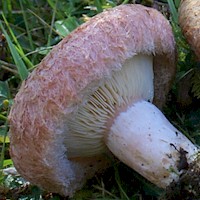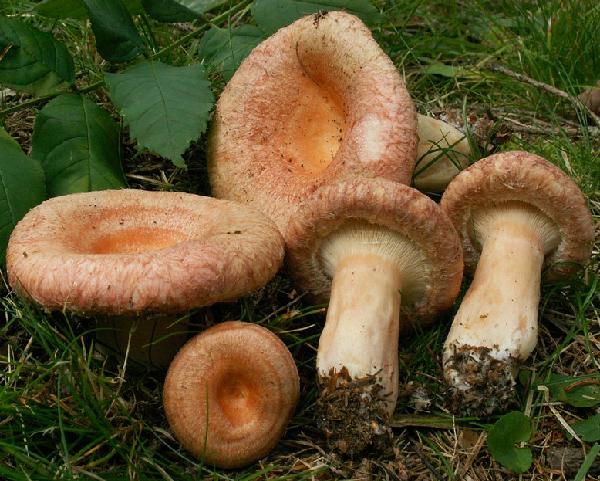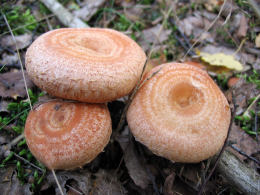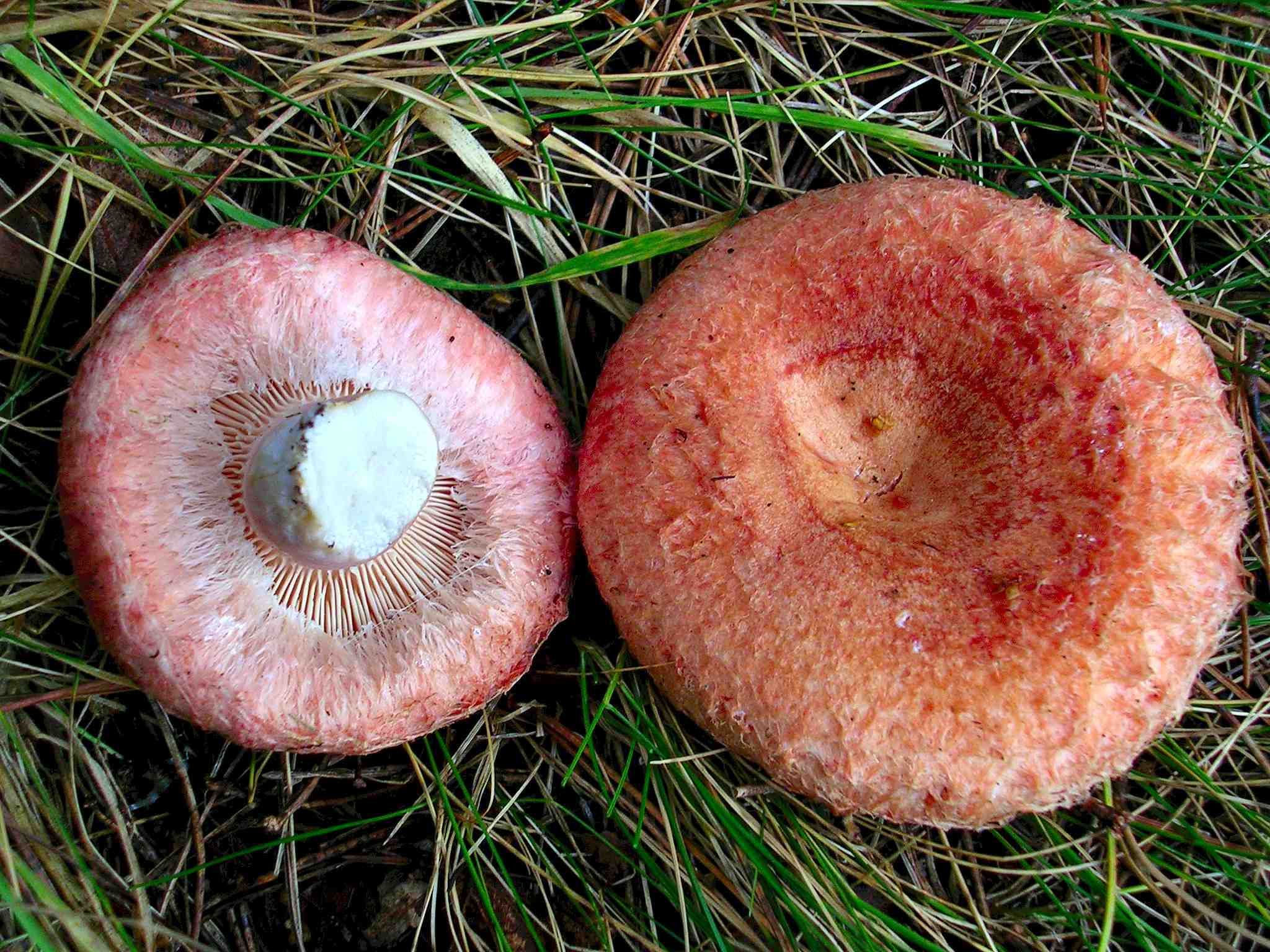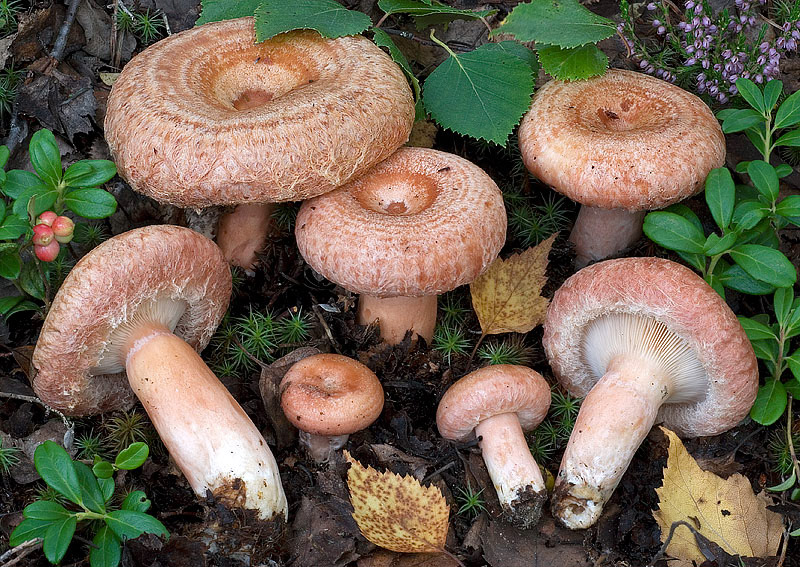Lactarius torminosus
Birch Milchling ( Lactarius torminosus )
The Birch Milchling ( Lactarius torminosus ) is a species of fungus in the family Täublingsverwandten. It is a fairly common, medium-sized Milchling with highly rolled-up, tomentose - villous border. The hat is yellowish pink and has several darker concentric zones. The stem is hollow and soon has often pitted spots. The Milchling has plenty of white, burning sharp milky sap and is therefore slightly poisonous, but he is eaten in many Eastern European countries after appropriate pretreatment. The Latin Artattribut ( epithet ) torminosus means suffering from colic. Other names for these typical birch companions are Shaggy Birch Milchling, but also Lactarius or Shaggy Reizker, although it is in the way to no "real " saffron milk cap.
- 5.1 Infra Generic Systematics
Features
Macroscopic characteristics
The hat is 5-12 (-15 ) cm wide and initially curved and spread later. The center is recessed slightly in mature specimens, old fruiting bodies are flat funnel-shaped. The pale salmon-colored, pink, flesh to flesh- reddish brown hat has concentrically arranged rings of lighter and darker zones. The colors fade in old age a little. The edge is rolled long and has a shaggy -haired lacing. The hat surface is greasy and matted with moisture. Old specimens tend to Verkahlen.
The off-white to pale pink colored and solid stem is 2-8 (9 ) cm long and 1-2 ( 3) inches thick and often shows pitted, flesh- pink spots. It is hollow with increasing age.
The slats are very crowded and have just grown or easily run down the stalk, stalk in proximity, they are often forked. They are whitish flesh-colored cream to pale. The spore powder is pale yellowish.
The flesh is white, firm but brittle. With injuries, it secretes from white, unchanging milk. This is like the flesh of fruit -like odor and taste sharp.
The burning hot and plentiful milk is pure white. You can not or only barely turns yellow. Only on a white handkerchief is a slight yellowing determine.
The hard, firm and brittle flesh is white to pale pink and smells slightly fruity or geraniumartig. It tastes like the milk burning sharp.
Microscopic characteristics
The spores are about 8-10 microns long and 6-8 microns wide. They are roughly spherical to broadly elliptical. The amyloid ornament on the surface of the spores is partly reticular, with broken ridges and some isolated warts. The protuberances are about 0.5-0.7 microns high. The Apiculus is very distinctive. The club- shaped to cylindrical basidia, which are the spore -bearing cells are 30 to 47.7 microns long and 7.3 to 8.2 micrometers wide. They each carry four spores. The pleurocystidia are Makrozystiden, so very long cystidia, which are embedded in the hymenium where they usually also have their origin. However, some originate in the upper Subhymenium. They are 40-80 microns long and 5-9.5 microns wide. The Macrozystiden are abundant, they are spindle-shaped and bulbous and swollen often one-sided you taper gradually towards the tip, and their content is granular and hyaline. The cheilocystidia on the cutting blades are slightly smaller, about 30-52 microns long and 4.5-8.0 microns thick, but otherwise correspond to the Macrozystiden
Artabgrenzung
The Birch Milchling is referred to in many fungal leaders than double of the precious Reizkers (L. deliciosus ). However, both species have only a distant resemblance, which is a birch, a companion, the other grows under pines. Just the milk white color here, there orange differs so clear that no confusion is possible.
A great similarity exists, however, the fringe - Milchling or Pale Zottenreizker (L. citriolens ), who also found under birch trees, a bearded edge has and is also more or less concentrically zoned. He is colored pale yellow and has a more full even when ripe (not hollow ) shaft. His flesh turns yellowish in section and smells significantly by geranium leaves or old lemons.
Another extremely rare in Germany is kind of eyelash Milchling ( Lactarius resimus ). Its fruiting bodies are initially whitish and later stained more yellowish. The hat is more or less ungezont. The Milchling is a birch companion who prefers nutrient- poor, acid sandy soils. Also the Fluffy Milchling, which also grows under birch trees, very similar to the Birch Milchling in shape and surface. However, the hat is colored whitish to pale pink and always ungezont. The spores are 6-8.5 × 5-6.5 microns smaller.
Ecology
The Birch Milchling is a mycorrhizal fungus that is bound in Germany strictly to the birch. In North America, but he can enter into a partnership with hemlock Tsuga or aspens. You can find the fungus usually gregarious in forests, gardens and parks, where it grows under or birch. The Milchling is not tied to specific forest types or companies and can occur almost anywhere, where his host the birch grows. He likes liked sour, dry to moderately moist soils, but is also found on other floors. The fruiting bodies occur between August and October.
Dissemination
The Birch Milchling is a Holarctic species native to the temperate and boreal climate zone and penetrates into subaktische areas. The fungus is found in North Asia ( Siberia, China, Korea and Japan ), North America (Mexico, USA, Canada and Greenland), the Canary Islands, North Africa and Europe. There is also evidence from New Zealand and Australia. The North American distribution extends north to the Yukon and up to Alaska, and south to Mexico. In Europe it is found mainly in the UK, Central, Eastern and Northern Europe. In Scandinavia, it is common to the arctic - alpine Lapland and also in Iceland it occurs. In Western and Southern Europe, the fungus is rare.
In Germany the Milchling is indeed widespread, but not very often, but despite a slight decline trends continue, the species is not endangered. In Austria and Switzerland, the species is widespread, though not often.
System
Infra Generic Systematics
The species is provided by M. Bon in the section Tricholomoidei. The members of this section have hats with frayed, or ragged woolen hat brim and always white milk. In some species, the milk can turn yellow clearly in the air. Close relatives are types of Downy birch and the Fringe Milchling
Feed value
The Birch Milchling is poisonous raw and without appropriate treatment. For the toxicity and the pungent taste terpenes are responsible. The poison affects especially on the gastro- intestinal tract, the mucous membranes become irritated (gastrointestinal intoxication). As a result, symptoms may after a latency period of half to three hours abdominal pain, colic, cramps, severe diarrhea and vomiting as well as acidosis and dehydration occur.
In Northern and Eastern Europe Birch Milchling (as well as many other pungent Milkcaps ) can still be collected in large quantities and eaten after appropriate pretreatment without discomfort. These mushrooms are chopped, washed overnight, boiled in fresh water for 5 minutes and after draining the brewing water used as other fungi. Often, they are then pickled in brine or vinegar flavored. In this process, the harmful, contained in the milk resinous and bitter substances are removed.


